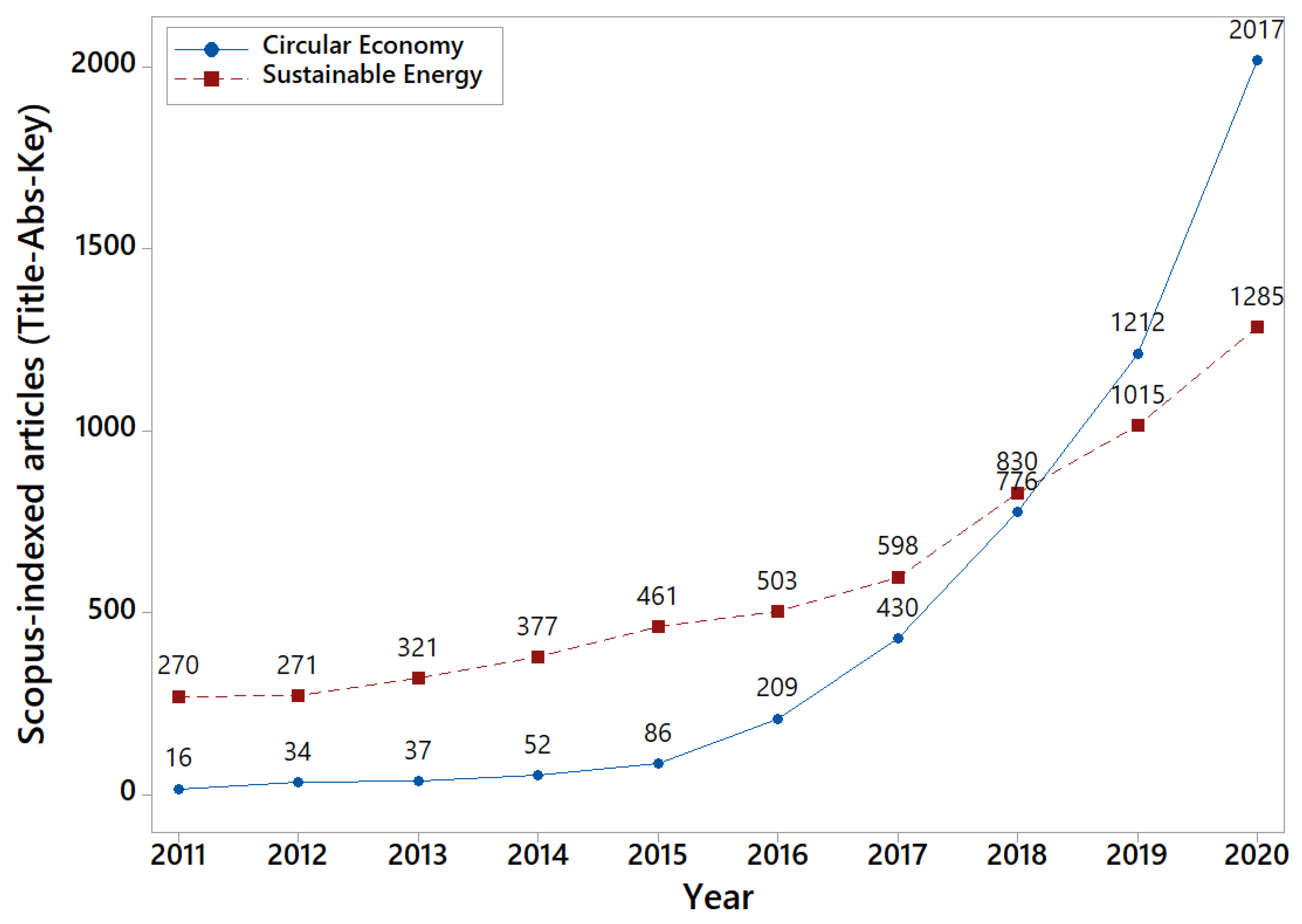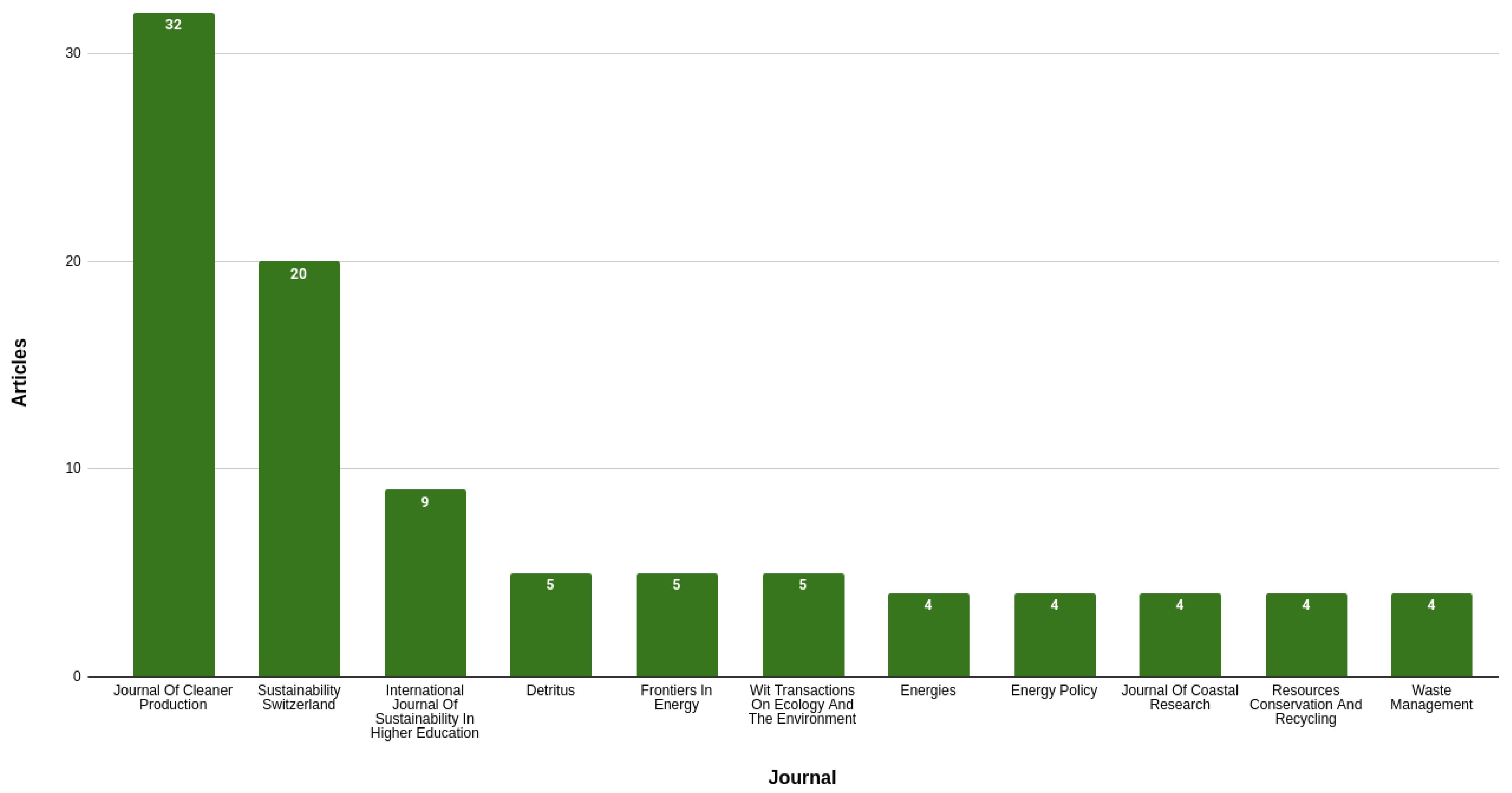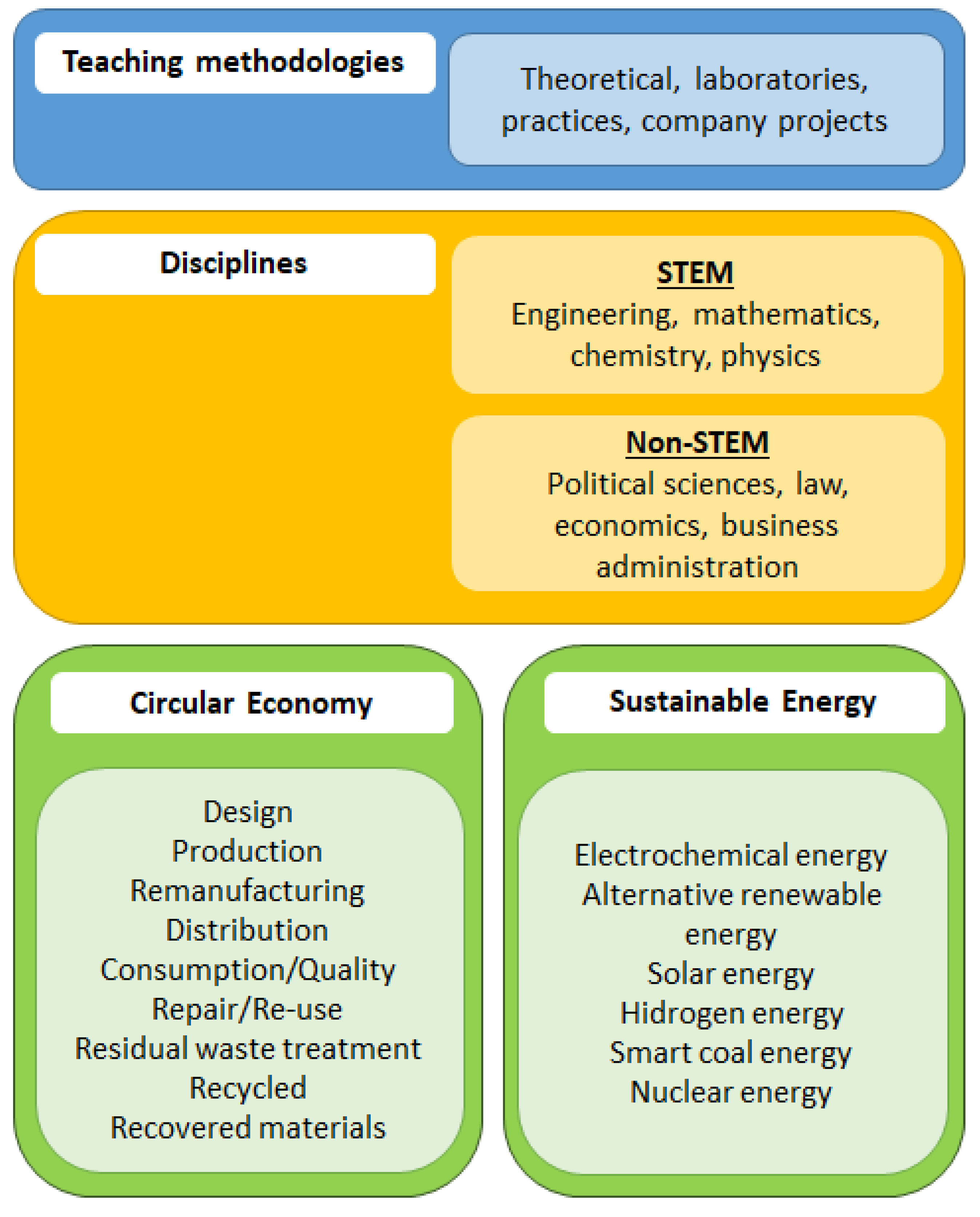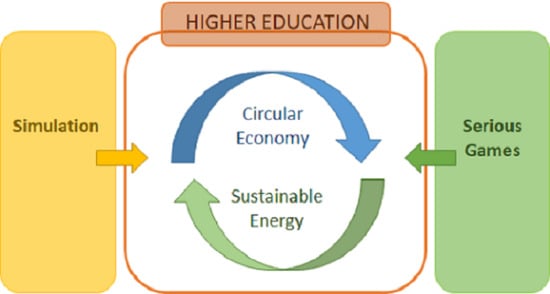The Role of Simulation and Serious Games in Teaching Concepts on Circular Economy and Sustainable Energy
Abstract
1. Introduction
2. Research Landscape
3. Literature Review
3.1. Circular Economy
3.2. Sustainability
4. The Role of Simulation-Based Learning
5. The Role of Serious Games
6. An Experience Including Sustainability Criteria in Master Courses
7. Discussion and Conclusions
- Simulation models help create a wide range of practice opportunities and are one of the most effective tools known for analyzing real-word in a simplified way [88,89]. In addition, SBL can be applied from the beginning of students’ academic life and allows them to adapt to their difficulties (both for beginners and advanced learners) [90]. It is important to mention that one of the main challenges is that simplifications should maintain value-neutrality, so as not to be biased towards a certain sustainability dimension (e.g., economic, social, or environment) and non-dogmatism (e.g., neither overly enthusiastic nor skeptical). Similarly, the overall teaching material has to be aligned with the same principles, that is, should also be value-neutral and non-dogmatic. Moreover, a static model structure does not reflect possible changes in the real world when simulating medium to long-term plan.
- The literature showed some examples that suggest that educators consider SBL a high impact tool for teaching about the complex, systemic challenges that come with social and environmental sustainability [50,91,92,93]. However, more empirical evidence is needed to evaluate the effectiveness of SBL. Designing an experiment to compare the effectiveness of SBL for a complex topic such as circular economy and sustainable energy is challenging. First, we have to take into account the adaptability of the tool according to students’ personal abilities, capabilities and knowledge, so any disadvantage in achieving the learning objectives can be avoided. Secondly, the difficulty in getting a good sample size may affect the statistical power of the conclusion [50].
- Evidence indicates that there are some serious games that fully contribute to the educational purpose of sustainable development (including the three dimensions, economic, social, and environmental). However, the use of serious games in sustainability is still incipient, and many of the games generated just include two out of the three aforementioned dimensions (i.e., generally both the social and environmental dimensions serve as a supporting feature while reflecting on the economic aspect) [94,95]. Considering its capacity of adaptation to different teaching methodologies and contents, it is mandatory to encourage a more integrative approach while considering the three dimensions.
- Despite the growing interest and the benefits of the application of serious games as tools in the field of HE, we should emphasize that the development of these games can be complex, expensive, and entail significant challenges (such as the exemplification of reality). One possible direction for future research would be experiential development that helps unravel the keys to achieving holistic learning [69].
Author Contributions
Funding
Institutional Review Board Statement
Informed Consent Statement
Data Availability Statement
Acknowledgments
Conflicts of Interest
References
- UNESCO. The Belgrade Charter: A Framework for Environmental Education. In Proceedings of the International Workshop on Environmental Education, Belgrade, Serbia, 13–22 October 1975; pp. 13–22. [Google Scholar]
- Bonnett, M. Environmental concern, moral education and our place in nature. J. Moral Educ. 2012, 41, 285–300. [Google Scholar] [CrossRef]
- Kopnina, H.; Blewitt, J. Sustainable Business: Key Issues; Routledge: Oxon, UK, 2014. [Google Scholar]
- Ferrer-Balas, D.; Adachi, J.; Banas, S.; Davidson, C.I.; Hoshikoshi, A.; Mishra, A.; Motodoa, Y.; Onga, M.; Ostwald, M. An international comparative analysis of sustainability transformation across seven universities. Int. J. Sustain. High. Educ. 2008, 9, 295–316. [Google Scholar] [CrossRef]
- Cloud, J. The Essential Elements of Education for Sustainability (EfS) Editorial Introduction from the Guest Editor. J. Sustain. Educ. 2014, 6, 1–9. [Google Scholar]
- Costa Junior, J.D.; Diehl, J.C.; Secomandi, F. Educating for a systems design approach to complex societal problems. J. Eng. Des. 2018, 29, 65–86. [Google Scholar] [CrossRef]
- Pacheco, L.; Ningsu, L.; Pujol, T.; Gonzalez, J.R.; Ferrer, I. Impactful engineering education through sustainable energy collaborations with public and private entities. Int. J. Sustain. High. Educ. 2019, 20, 393–407. [Google Scholar] [CrossRef]
- Kılkış, Ş.; Kılkış, B. Integrated circular economy and education model to address aspects of an energy-water-food nexus in a dairy facility and local contexts. J. Clean. Prod. 2017, 167, 1084–1098. [Google Scholar] [CrossRef]
- Müller, P.A.; Bäumer, T.; Silberer, J.; Zimmermann, S. Using research methods courses to teach students about sustainable development–a three-phase model for a transformative learning experience. Int. J. Sustain. High. Educ. 2020, 21, 427–439. [Google Scholar] [CrossRef]
- Nunes, B.T.; Pollard, S.J.; Burgess, P.J.; Ellis, G.; De los Rios, I.C.; Charnley, F. University contributions to the circular economy: Professing the hidden curriculum. Sustainability 2018, 10, 2719. [Google Scholar] [CrossRef]
- Barbiroli, G. Eco-efficiency or/and eco-effectiveness? Shifting to innovative paradigms for resource productivity. Int. J. Sustain. Dev. World Ecol. 2006, 13, 391–395. [Google Scholar] [CrossRef]
- Korhonen, J.; Honkasalo, A.; Seppälä, J. Circular economy: The concept and its limitations. Ecol. Econ. 2018, 143, 37–46. [Google Scholar] [CrossRef]
- Prieto-Sandoval, V.; Jaca, C.; Ormazabal, M. Towards a consensus on the circular economy. J. Clean. Prod. 2018, 179, 605–615. [Google Scholar] [CrossRef]
- Kirchherr, J.; Reike, D.; Hekkert, M. Conceptualizing the circular economy: An analysis of 114 definitions. Resour. Conserv. Recycl. 2017, 127, 221–232. [Google Scholar] [CrossRef]
- Stahel, W.R. The circular economy. Nature 2016, 531, 435–438. [Google Scholar] [CrossRef]
- Geissdoerfer, M.; Savaget, P.; Bocken, N.M.; Hultink, E.J. The Circular Economy—A new sustainability paradigm? J. Clean. Prod. 2017, 143, 757–768. [Google Scholar] [CrossRef]
- Murray, A.; Skene, K.; Haynes, K. The circular economy: An interdisciplinary exploration of the concept and application in a global context. J. Bus. Ethics 2017, 140, 369–380. [Google Scholar] [CrossRef]
- Rizos, V.; Behrens, A.; Van der Gaast, W.; Hofman, E.; Ioannou, A.; Kafyeke, T.; Flamos, A.; Rinaldi, R.; Papadelis, S.; Hirschnitz-Garbers, M.; et al. Implementation of circular economy business models by small and medium-sized enterprises (SMEs): Barriers and enablers. Sustainability 2016, 8, 1212. [Google Scholar] [CrossRef]
- Fonseca, L.M.; Domingues, J.P.; Pereira, M.T.; Martins, F.F.; Zimon, D. Assessment of circular economy within Portuguese organizations. Sustainability 2018, 10, 2521. [Google Scholar] [CrossRef]
- Bocken, N.M.; De Pauw, I.; Bakker, C.; Van Der Grinten, B. Product design and business model strategies for a circular economy. J. Ind. Prod. Eng. 2016, 33, 308–320. [Google Scholar] [CrossRef]
- Winans, K.; Kendall, A.; Deng, H. The history and current applications of the circular economy concept. Renew. Sustain. Energy Rev. 2017, 68, 825–833. [Google Scholar] [CrossRef]
- Lieder, M.; Rashid, A. Towards circular economy implementation: A comprehensive review in context of manufacturing industry. J. Clean. Prod. 2016, 115, 36–51. [Google Scholar] [CrossRef]
- Kalmykova, Y.; Sadagopan, M.; Rosado, L. Circular economy—From review of theories and practices to development of implementation tools. Resour. Conserv. Recycl. 2018, 135, 190–201. [Google Scholar] [CrossRef]
- Whalen, K.A.; Berlin, C.; Ekberg, J.; Barletta, I.; Hammersberg, P. ‘All they do is win’: Lessons learned from use of a serious game for Circular Economy education. Resour. Conserv. Recycl. 2018, 135, 335–345. [Google Scholar] [CrossRef]
- Kirchherr, J.; Piscicelli, L. Towards an education for the circular economy (ECE): Five teaching principles and a case study. Resour. Conserv. Recycl. 2019, 150, 104406. [Google Scholar] [CrossRef]
- Suárez-Eiroa, B.; Fernández, E.; Méndez-Martínez, G.; Soto-Oñate, D. Operational principles of circular economy for sustainable development: Linking theory and practice. J. Clean. Prod. 2019, 214, 952–961. [Google Scholar] [CrossRef]
- Kopnina, H. Green-washing or best case practices? Using circular economy and Cradle to Cradle case studies in business education. J. Clean. Prod. 2019, 219, 613–621. [Google Scholar] [CrossRef]
- Mendoza, J.M.F.; Gallego-Schmid, A.; Azapagic, A. A methodological framework for the implementation of circular economy thinking in higher education institutions: Towards sustainable campus management. J. Clean. Prod. 2019, 226, 831–844. [Google Scholar] [CrossRef]
- Rokicki, T.; Perkowska, A.; Klepacki, B.; Szczepaniuk, H.; Szczepaniuk, E.K.; Bereziński, S.; Ziółkowska, P. The importance of higher education in the EU countries in achieving the objectives of the circular economy in the energy sector. Energies 2020, 13, 4407. [Google Scholar] [CrossRef]
- Sumter, D.; de Koning, J.; Bakker, C.; Balkenende, R. Circular economy competencies for design. Sustainability 2020, 12, 1561. [Google Scholar] [CrossRef]
- Barbier, E.B.; Burgess, J.C. Sustainable development goal indicators: Analyzing trade-offs and complementarities. World Dev. 2019, 122, 295–305. [Google Scholar] [CrossRef]
- Nerini, F.F.; Tomei, J.; To, L.S.; Bisaga, I.; Parikh, P.; Black, M.; Borrion, A.; Spataru, C.; Broto, V.C.; Anandarajah, G.; et al. Mapping synergies and trade-offs between energy and the Sustainable Development Goals. Nat. Energy 2018, 3, 10–15. [Google Scholar] [CrossRef]
- Singh, G.G.; Cisneros-Montemayor, A.M.; Swartz, W.; Cheung, W.; Guy, J.A.; Kenny, T.A.; McOwen, C.J.; Asch, R.; Geffert, J.L.; Wabnitz, C.C.; et al. A rapid assessment of co-benefits and trade-offs among Sustainable Development Goals. Mar. Policy 2018, 93, 223–231. [Google Scholar] [CrossRef]
- Fonseca, L.M.; Domingues, J.P.; Dima, A.M. Mapping the sustainable development goals relationships. Sustainability 2020, 12, 3359. [Google Scholar] [CrossRef]
- Zimon, D.; Tyan, J.; Sroufe, R. Drivers of sustainable supply chain management: Practices to alignment with un sustainable development goals. Int. J. Qual. Res. 2020, 14, 219–236. [Google Scholar] [CrossRef]
- Greenblatt, J.B.; Wei, M. Assessment of the climate commitments and additional mitigation policies of the United States. Nat. Clim. Chang. 2016, 6, 1090–1093. [Google Scholar] [CrossRef]
- Chu, S.; Cui, Y.; Liu, N. The path towards sustainable energy. Nat. Mater. 2017, 16, 16–22. [Google Scholar] [CrossRef]
- Panwar, N.; Kaushik, S.; Kothari, S. Role of renewable energy sources in environmental protection: A review. Renew. Sustain. Energy Rev. 2011, 15, 1513–1524. [Google Scholar] [CrossRef]
- Trindade, E.P.; Hinnig, M.P.F.; Moreira da Costa, E.; Marques, J.S.; Bastos, R.C.; Yigitcanlar, T. Sustainable development of smart cities: A systematic review of the literature. J. Open Innov. Technol. Mark. Complex. 2017, 3, 11. [Google Scholar] [CrossRef]
- Bibri, S.E. A foundational framework for smart sustainable city development: Theoretical, disciplinary, and discursive dimensions and their synergies. Sustain. Cities Soc. 2018, 38, 758–794. [Google Scholar] [CrossRef]
- Beneicke, J.; Juan, A.A.; Xhafa, F.; Lopez-Lopez, D.; Freixes, A. Empowering Citizens’ Cognition and Decision Making in Smart Sustainable Cities. IEEE Consum. Electron. Mag. 2019, 9, 102–108. [Google Scholar] [CrossRef]
- Bracco, S.; Delfino, F.; Laiolo, P.; Morini, A. Planning & open-air demonstrating smart city sustainable districts. Sustainability 2018, 10, 4636. [Google Scholar]
- Nowotny, J.; Dodson, J.; Fiechter, S.; Gür, T.M.; Kennedy, B.; Macyk, W.; Bak, T.; Sigmund, W.; Yamawaki, M.; Rahman, K.A. Towards global sustainability: Education on environmentally clean energy technologies. Renew. Sustain. Energy Rev. 2018, 81, 2541–2551. [Google Scholar] [CrossRef]
- Tchamyou, V.S. Education, lifelong learning, inequality and financial access: Evidence from African countries. Contemp. Soc. Sci. 2020, 15, 7–25. [Google Scholar] [CrossRef]
- Bonilla, S.H.; Almeida, C.M.; Giannetti, B.F.; Huisingh, D. The roles of cleaner production in the sustainable development of modern societies: An introduction to this special issue. J. Clean. Prod. 2010, 18, 1–5. [Google Scholar] [CrossRef]
- Khalili, N.R.; Duecker, S.; Ashton, W.; Chavez, F. From cleaner production to sustainable development: The role of academia. J. Clean. Prod. 2015, 96, 30–43. [Google Scholar] [CrossRef]
- von Blottnitz, H.; Case, J.M.; Fraser, D.M. Sustainable development at the core of undergraduate engineering curriculum reform: A new introductory course in chemical engineering. J. Clean. Prod. 2015, 106, 300–307. [Google Scholar] [CrossRef]
- Leal Filho, W.; Raath, S.; Lazzarini, B.; Vargas, V.; De Souza, L.; Anholon, R.; Quelhas, O.; Haddad, R.; Klavins, M.; Orlovic, V. The role of transformation in learning and education for sustainability. J. Clean. Prod. 2018, 199, 286–295. [Google Scholar] [CrossRef]
- McHaney, R.; Reiter, L.; Reychav, I. Immersive Simulation in Constructivist-Based Classroom E-Learning. Int. J. E-Learn. 2018, 14, 29–64. [Google Scholar]
- Prado, A.M.; Arce, R.; Garcia, J.; Pearson, A.A. Simulations Versus Case Studies: Effectively Teaching the Premises of Sustainable Development in the Classroom. J. Bus. Ethics 2020, 161, 303–327. [Google Scholar] [CrossRef]
- Greenwood, A.G. Striving for ubiquity of simulation in operations through educational enhancements. In Proceedings of the 2017 Winter Simulation Conference, Las Vegas, NV, USA, 3–6 December 2017; pp. 4252–4263. [Google Scholar]
- Marques, C.; Bachega, S.J.; Tavares, D.M. Framework proposal for the environmental impact assessment of universities in the context of Green IT. J. Clean. Prod. 2019, 241, 118346. [Google Scholar] [CrossRef]
- Klimova, A.; Rondeau, E.; Andersson, K.; Porras, J.; Rybin, A.; Zaslavsky, A. An international Master’s program in green ICT as a contribution to sustainable development. J. Bus. Ethics 2016, 135, 223–239. [Google Scholar] [CrossRef]
- Lieder, M.; Asif, F.M.; Rashid, A. Towards Circular Economy implementation: An agent-based simulation approach for business model changes. Auton. Agents Multi-Agent Syst. 2017, 31, 1377–1402. [Google Scholar] [CrossRef]
- Górecki, J. Simulation-Based Positioning of Circular Economy Manager’s Skills in Construction Projects. Symmetry 2020, 12, 50. [Google Scholar] [CrossRef]
- Demestichas, K.; Daskalakis, E. Information and Communication Technology Solutions for the Circular Economy. Sustainability 2020, 12, 7272. [Google Scholar] [CrossRef]
- Bag, S.; Wood, L.C.; Mangla, S.K.; Luthra, S. Procurement 4.0 and its implications on business process performance in a circular economy. Resour. Conserv. Recycl. 2020, 152, 104502. [Google Scholar] [CrossRef]
- Franco, M.A. A system dynamics approach to product design and business model strategies for the circular economy. J. Clean. Prod. 2019, 241, 118327. [Google Scholar] [CrossRef]
- Rivas, D.F.; Boffito, D.C.; Faria-Albanese, J.; Glassey, J.; Cantin, J.; Afraz, N.; Akse, H.; Boodhoo, K.V.; Bos, R.; Chiang, Y.W.; et al. Process intensification education contributes to sustainable development goals. Part 2. Educ. Chem. Eng. 2020, 32, 15–24. [Google Scholar] [CrossRef]
- Benner, J.; McArthur, J.J. Data-Driven Design as a Vehicle for BIM and Sustainability Education. Buildings 2019, 9, 103. [Google Scholar] [CrossRef]
- Jin, R.; Yang, T.; Piroozfar, P.; Kang, B.G.; Wanatowski, D.; Hancock, C.M.; Tang, L. Project-based pedagogy in interdisciplinary building design adopting BIM. Eng. Constr. Archit. Manag. 2018, 25, 1376–1397. [Google Scholar] [CrossRef]
- Gugerell, K.; Zuidema, C. Gaming for the energy transition. Experimenting and learning in co-designing a serious game prototype. J. Clean. Prod. 2017, 169, 105–116. [Google Scholar] [CrossRef]
- Energy Transition Game. Available online: https://energytransition.games4sustainability.org/en/ (accessed on 16 December 2020).
- Campos, N.; Nogal, M.; Caliz, C.; Juan, A.A. Simulation-based education involving online and on-campus models in different European universities. Int. J. Educ. Technol. High. Educ. 2020, 17, 1–15. [Google Scholar] [CrossRef]
- Whalen, K. Risk & race: Creation of a finance-focused circular economy serious game. Prod. Lifetimes Environ. 2017, 422–425. [Google Scholar] [CrossRef]
- Bocken, N.; Strupeit, L.; Whalen, K.; Nußholz, J. A review and evaluation of circular business model innovation tools. Sustainability 2019, 11, 2210. [Google Scholar] [CrossRef]
- Climate Change (Serious Game). Available online: www.bbc.co.uk/sn/hottopics/climatechange/climatechallenge/ (accessed on 16 December 2020).
- Energyville (Serious Game). Available online: http://zielonegry.crs.org.pl/gamepedia/energyville-2/ (accessed on 16 December 2020).
- Stanitsas, M.; Kirytopoulos, K.; Vareilles, E. Facilitating sustainability transition through serious games: A systematic literature review. J. Clean. Prod. 2019, 208, 924–936. [Google Scholar] [CrossRef]
- Rai, V.; Beck, A.L. Play and learn: Serious games in breaking informational barriers in residential solar energy adoption in the United States. Energy Res. Soc. Sci. 2017, 27, 70–77. [Google Scholar] [CrossRef]
- Scurati, G.W.; Ferrise, F.; Bertoni, M. Sustainability awareness in organizations through gamification and serious games: A systematic mapping. In Proceedings of the DS 101: NordDesign 2020, Lyngby, Denmark, 12–14 August 2020; pp. 1–10. [Google Scholar]
- Whalen, K.; Kijne, G. Game-Based Approaches to Sustainable Innovation. In Innovation for Sustainability; Springer: Cham, Switzerland, 2019; pp. 375–392. [Google Scholar]
- Robin, V.; Pache, A.; Perpignan, C.; Dessagne, D. Serious games to promote education for sustainable development, a French and Swiss experimentation. In Proceedings of the 2017 IEEE Global Engineering Education Conference (EDUCON), Athens, Greece, 25–28 April 2017; pp. 806–814. [Google Scholar]
- Juan, A.A.; Kelton, W.D.; Currie, C.S.; Faulin, J. Simheuristics applications: Dealing with uncertainty in logistics, transportation, and other supply chain areas. In Proceedings of the Winter Simulation Conference, Gothenburg, Sweden, 9–12 December 2018; pp. 3048–3059. [Google Scholar]
- Juan, A.A.; Huertas, A.; Steegmann, C.; Córcoles, C.; Serrat, C. Mathematical e-learning: State of the art and experiences at the open University of Catalonia. Int. J. Math. Educ. Sci. Technol. 2008, 39, 455–471. [Google Scholar] [CrossRef]
- Gonzalez-Martin, S.; Juan, A.A.; Riera, D.; Elizondo, M.G.; Ramos, J.J. A simheuristic algorithm for solving the arc routing problem with stochastic demands. J. Simul. 2018, 12, 53–66. [Google Scholar] [CrossRef]
- Gruler, A.; Pérez-Navarro, A.; Calvet, L.; Juan, A.A. A simheuristic algorithm for time-dependent waste collection management with stochastic travel times. Stat. Oper. Res. Trans. 2020, 44, 285–310. [Google Scholar]
- Panadero, J.; Juan, A.A.; Bayliss, C.; Currie, C. Maximising reward from a team of surveillance drones: A simheuristic approach to the stochastic team orienteering problem. Eur. J. Ind. Eng. 2020, 14, 485–516. [Google Scholar] [CrossRef]
- Reyes-Rubiano, L.S.; Faulin, J.; Calvet, L.; Juan, A.A. A simheuristic approach for freight transportation in smart cities. In Proceedings of the Winter Simulation Conference, Las Vegas, NV, USA, 3–6 December 2017; pp. 3346–3357. [Google Scholar]
- Chica, M.; Juan, A.A.; Christopher, B.; Oscar, C.; David, K.W. Why simheuristics? Benefits, limitations, and best practices when combining metaheuristics with simulation. Stat. Oper. Res. Trans. 2020, 44, 311–334. [Google Scholar] [CrossRef]
- Serrano-Hernández, A.; Juan, A.A.; Faulin, J.; Perez-Bernabeu, E. Horizontal collaboration in freight transport: Concepts, benefits and environmental challenges. Stat. Oper. Res. Trans. 2017, 1, 393–414. [Google Scholar]
- Londoño, J.C.; Tordecilla, R.D.; Martins, L.D.C.; Juan, A.A. A biased-randomized iterated local search for the vehicle routing problem with optional backhauls. TOP Off. J. Span. Soc. Stat. Oper. Res. 2020, 1–30. [Google Scholar] [CrossRef]
- Quintero-Araujo, C.L.; Gruler, A.; Juan, A.A.; Faulin, J. Using horizontal cooperation concepts in integrated routing and facility-location decisions. Int. Trans. Oper. Res. 2019, 26, 551–576. [Google Scholar] [CrossRef]
- Belloso, J.; Juan, A.A.; Faulin, J. An iterative biased-randomized heuristic for the fleet size and mix vehicle-routing problem with backhauls. Int. Trans. Oper. Res. 2019, 26, 289–301. [Google Scholar] [CrossRef]
- Quintero-Araujo, C.L.; Caballero-Villalobos, J.P.; Juan, A.A.; Montoya-Torres, J.R. A biased-randomized metaheuristic for the capacitated location routing problem. Int. Trans. Oper. Res. 2017, 24, 1079–1098. [Google Scholar] [CrossRef]
- Juan, A.A.; Faulin, J.; Ruiz, R.; Barrios, B.; Gilibert, M.; Vilajosana, X. Using oriented random search to provide a set of alternative solutions to the capacitated vehicle routing problem. In Operations Research and Cyber-Infrastructure; Springer: Boston, MA, USA, 2009; pp. 331–345. [Google Scholar]
- Fikar, C.; Juan, A.A.; Martinez, E.; Hirsch, P. A discrete-event driven metaheuristic for dynamic home service routing with synchronised trip sharing. Eur. J. Ind. Eng. 2016, 10, 323–340. [Google Scholar] [CrossRef]
- Barab, S.A.; Squire, K.D.; Dueber, W. A co-evolutionary model for supporting the emergence of authenticity. Educ. Technol. Res. Dev. 2000, 48, 37–62. [Google Scholar] [CrossRef]
- Cook, D.A. How much evidence does it take? A cumulative meta-analysis of outcomes of simulation-based education. Med. Educ. 2014, 48, 750–760. [Google Scholar] [CrossRef]
- Chernikova, O.; Heitzmann, N.; Stadler, M.; Holzberger, D.; Seidel, T.; Fischer, F. Simulation-based learning in higher education: A meta-analysis. Rev. Educ. Res. 2020, 90, 499–541. [Google Scholar] [CrossRef]
- Klopfer, E.; Squire, K. Environmental Detectives—The development of an augmented reality platform for environmental simulations. Educ. Technol. Res. Dev. 2008, 56, 203–228. [Google Scholar] [CrossRef]
- Sterman, J. Interactive web-based simulations for strategy and sustainability: The MIT Sloan LearningEdge management flight simulators, Part I. Syst. Dyn. Rev. 2014, 30, 89–121. [Google Scholar] [CrossRef]
- Gatti, L.; Ulrich, M.; Seele, P. Education for sustainable development through business simulation games: An exploratory study of sustainability gamification and its effects on students’ learning outcomes. J. Clean. Prod. 2019, 207, 667–678. [Google Scholar] [CrossRef]
- Madani, K.; Pierce, T.W.; Mirchi, A. Serious games on environmental management. Sustain. Cities Soc. 2017, 29, 1–11. [Google Scholar] [CrossRef]
- Suppipat, S.; Hu, A.H.; Chotiratanapinun, T. Gamifying Sustainable Design to Enhance Environmental Consciousness of Industrial Design Students. In EcoDesign and Sustainability II; Springer: Singapore, 2020; pp. 291–310. [Google Scholar]







Publisher’s Note: MDPI stays neutral with regard to jurisdictional claims in published maps and institutional affiliations. |
© 2021 by the authors. Licensee MDPI, Basel, Switzerland. This article is an open access article distributed under the terms and conditions of the Creative Commons Attribution (CC BY) license (http://creativecommons.org/licenses/by/4.0/).
Share and Cite
de la Torre, R.; Onggo, B.S.; Corlu, C.G.; Nogal, M.; Juan, A.A. The Role of Simulation and Serious Games in Teaching Concepts on Circular Economy and Sustainable Energy. Energies 2021, 14, 1138. https://doi.org/10.3390/en14041138
de la Torre R, Onggo BS, Corlu CG, Nogal M, Juan AA. The Role of Simulation and Serious Games in Teaching Concepts on Circular Economy and Sustainable Energy. Energies. 2021; 14(4):1138. https://doi.org/10.3390/en14041138
Chicago/Turabian Stylede la Torre, Rocio, Bhakti S. Onggo, Canan G. Corlu, Maria Nogal, and Angel A. Juan. 2021. "The Role of Simulation and Serious Games in Teaching Concepts on Circular Economy and Sustainable Energy" Energies 14, no. 4: 1138. https://doi.org/10.3390/en14041138
APA Stylede la Torre, R., Onggo, B. S., Corlu, C. G., Nogal, M., & Juan, A. A. (2021). The Role of Simulation and Serious Games in Teaching Concepts on Circular Economy and Sustainable Energy. Energies, 14(4), 1138. https://doi.org/10.3390/en14041138








